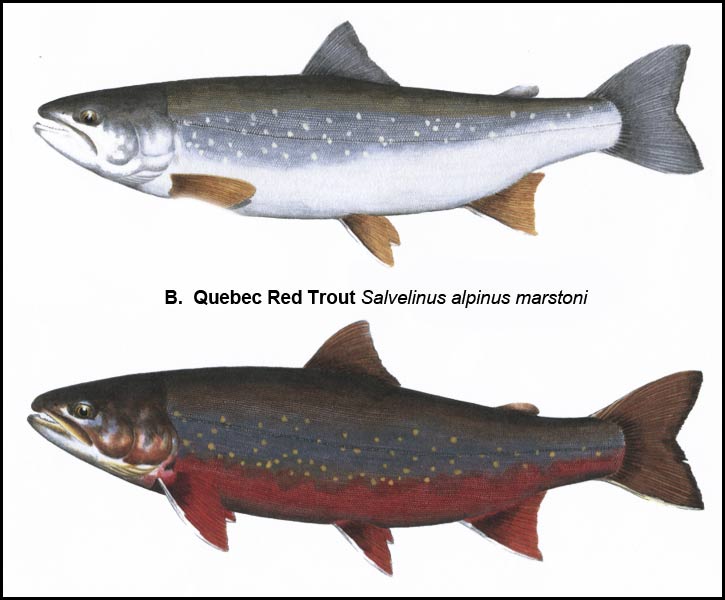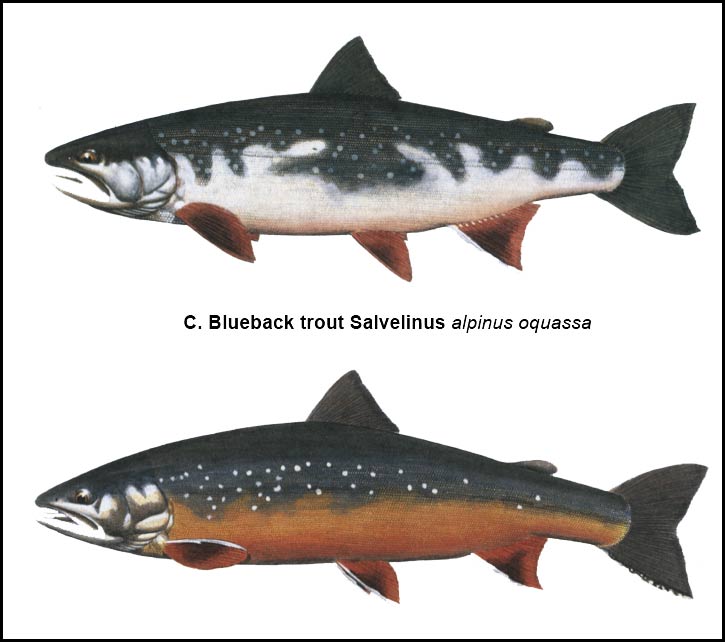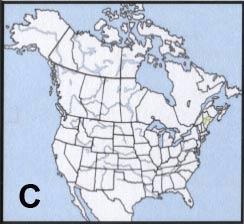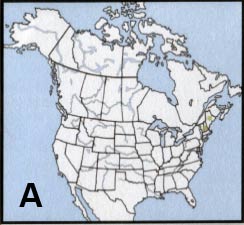Landlocked Arctic Char, October 2012, Fish of the Month!


A. Sunapee (Golden) trout
Salvelinus alpinus aureolus
B. Quebec Red trout
Salvelinus alpinus marstoni
C. Blueback trout
Salvelinus alpinus oquassa

Local Names:
A. Golden trout, Sunapee trout, Gray trout
B. Red trout, Lake char, Char, Marston' trout
C. Trout, Blueback
Average Size:
8 to 16 inches
0.5 to 1 lb.
(In certain fertile northern waters, landlocked Arctic char attain much larger than average size.)
Distinguishing Field Marks:
Color and color pattern are reliable distinguishing field marks for this species. (See the illustration.)
-
The mouth is large.
-
The upper jaw extends well beyond the rear edge of the eye.
-
The anal fin has 8 to 11 primary rays.
-
All chars have light spots on a darker background.
-
The caudal, anal, pelvic, and pectoral fins have white leading edges, as does the bottom edge of the caudal (tail).
-
The are no spots on the fins.
-
The anal, pelvic, and pectoral fins become brightly colored in spawning adults.
-
The caudal (tail) fin is moderately forked with a narrow peduncle.
North American Range:
These three elegant chars have very small New England and Southeastern Canadian ranges and have not been widely transplanted. Maps to the right shows approximate range in North America.
Diet:
Young landlocked Arctic char feed on aquatic insects and other invertebrates. As they are available, small forage fishes become a staple in the diets of larger adults.
Biology:
Both landlocked and sea-run Arctic char spawn in the early fall in the northern reaches of their range and later in the south. The spawning period is from September through early December. Spawning takes place either in shallow lake water or in quiet pools of rivers. Spawning is not as showy as in other salmonid species. When the female has opened a nest site, she is joined by one male which usually attends her through her entire release of eggs, fertilizing them as they are deposited. Individual males may breed with more than one female.
In most of their range, female Arctic char spawn only every second or third year.
The fertilized eggs incubate in the gravel through the winter months and usually hatch around early April, but remain in the nest gravel until as late as early July.
Landlocked Arctic char may be spawned in tributary streams or in the lake itself. They grow more slowly and attain generally smaller sizes than their sea-run counterparts.
Fly Fishing for Landlocked Arctic char:
I'm including these three subspecies not because anyone would be well advised to book a fly-fishing trip into their ranges, but rather because they are a "canary in the mine" statement of how our human behavior regarding fish can cause irreparable damage, and because they are all quite elegantly beautiful. Because their homes are in sterile, short growing season northern habitats, these chars are extremely vulnerable to both fishing and habitat degradation pressures, including the introduction of competing fish species. It is only in the far north of their range that populations of landlocked Arctic char have remained intact.
Should you find yourself in char waters and choose to fish for them, in most cases, you're likely to need equipment no heavier than 5 or 6 weight. Depending on what forage is available, hatch-matching dries, nymphs, wets, and small streamer flies are appropriate. Again, only in the northern parts of their range will these fish be readily available to fly-rodders for more than a few weeks in spring and fall. Like both Brook trout and Lake trout, these chars prefer water temperatures in the mid-50s. This preference will have them near the surface of lakes and ponds only when those waters have "turned over" and are about the same temperature from top to bottom. During the warmer summer months, chars will sink deeper and deeper as does the thermocline. As we know, every rule has exceptions, and so it is with these fish. In some of their northern native waters, which they share with Brook trout, these char can grow to impressive size and, because of their latitudes, will see both Brook trout and char surface feeding throughout the season.








